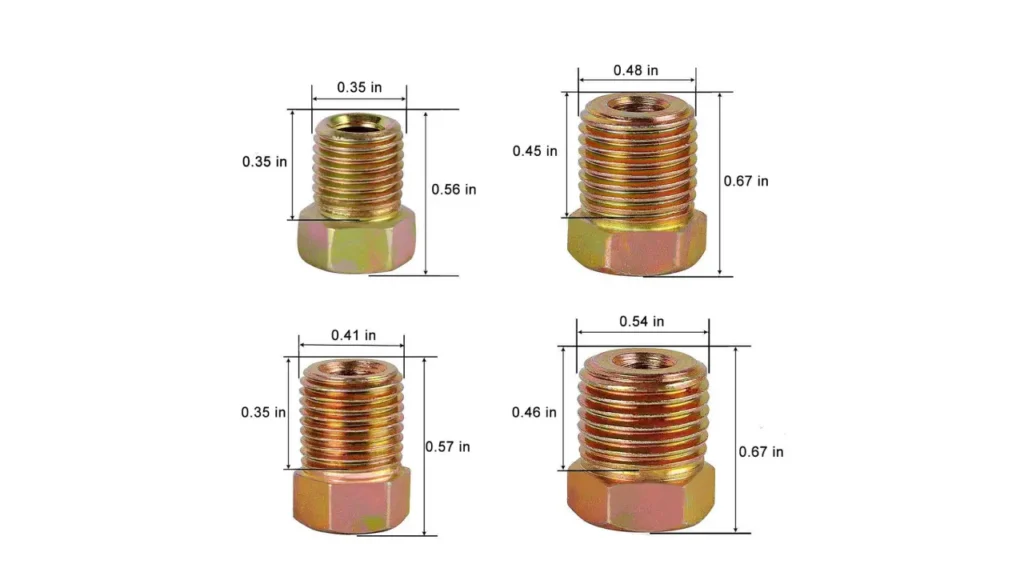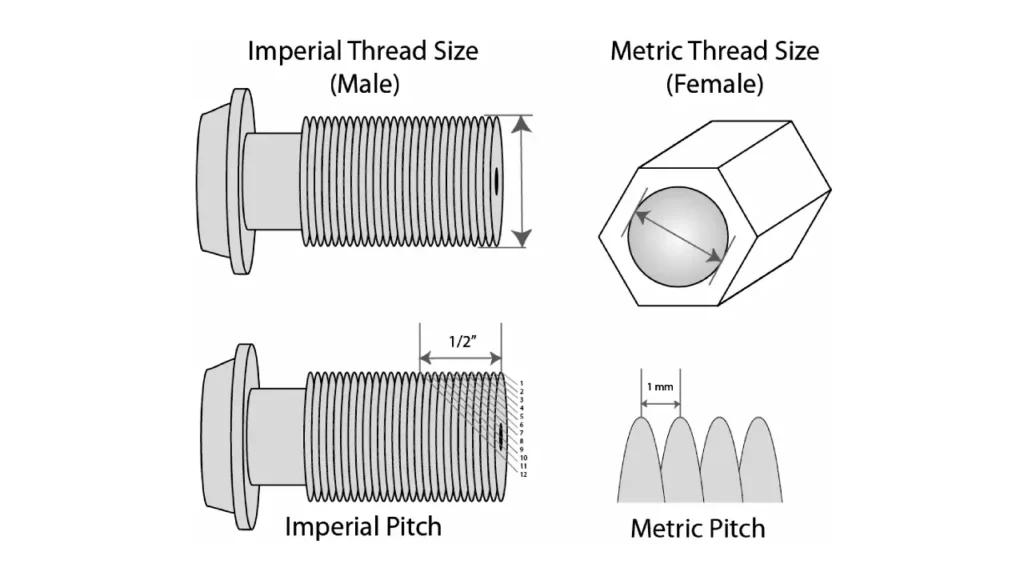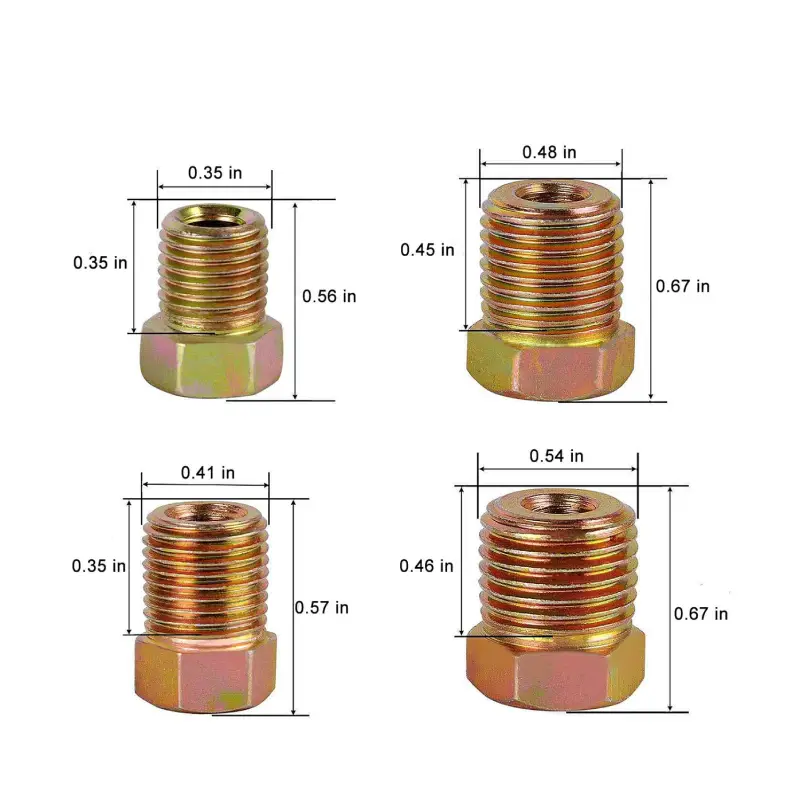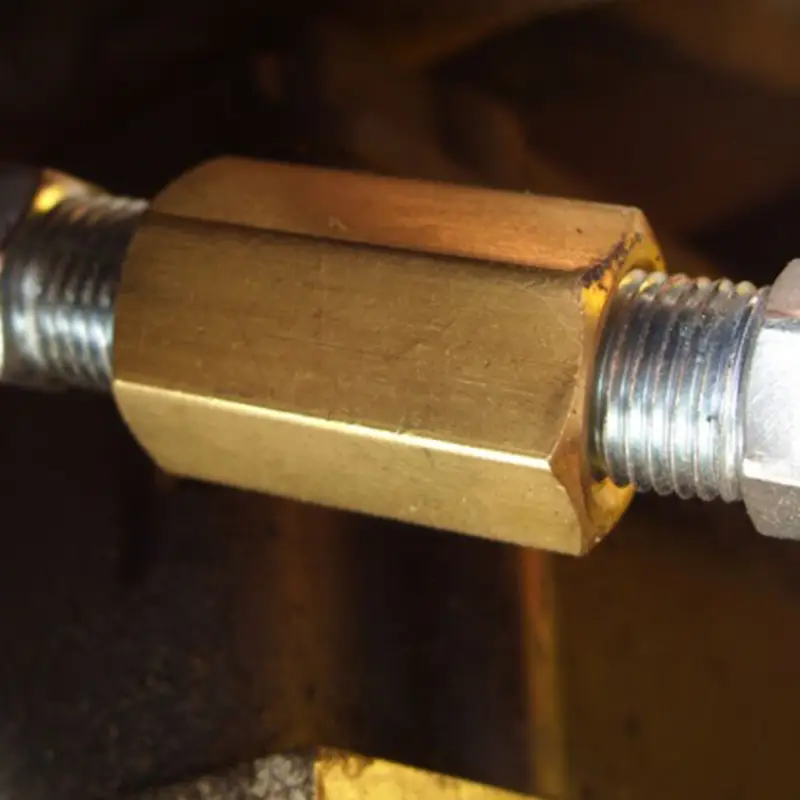Accurately measuring brake line fitting sizes is essential for ensuring proper connections and preventing leaks in your vehicle’s braking system. Incorrect fittings can lead to compromised brake performance and safety risks. This guide provides a comprehensive overview of how to measure brake line fitting sizes, covering the necessary tools and techniques.
Understanding the various types of brake line fittings and their specific measurements is crucial for both DIY enthusiasts and professional mechanics. This blog will explore the different sizes, threads, and flare types, helping you select the correct fittings for your vehicle. By following these guidelines, you can confidently measure and choose the appropriate fittings, ensuring a secure and reliable braking system.
Brake Line Fitting Sizes

Brake line fitting sizes are crucial for ensuring a secure and leak-free connection within your vehicle’s braking system. These fittings come in various dimensions, typically measured in inches or millimeters, and are often identified by their thread size and flare type. Accurate measurement is essential for compatibility when replacing or repairing brake lines. Incorrect sizes can lead to leaks, compromised braking performance, and potential safety hazards.
Understanding the different measurement standards and thread types is vital when dealing with brake line fittings. Thread sizes, such as 3/16-inch or 1/4-inch, indicate the diameter of the threaded portion, while flare types, like inverted or bubble flares, determine the shape of the fitting’s end. Precise tools, such as calipers and thread gauges, are necessary for accurate measurements, ensuring you select the correct fittings for your specific application.
How to Measure Brake Line Fitting Sizes

Accurately measuring brake line fitting sizes is essential for ensuring proper fit and function within your vehicle’s braking system. Incorrect measurements can lead to leaks and compromised braking performance. This guide outlines the steps to measure brake line fitting sizes correctly.
Step 1: Identify the Fitting Type
Begin by identifying the type of brake line fitting you need to measure. Common types include inverted flare, bubble flare, and compression fittings. Each type has distinct characteristics that affect measurement techniques. Knowing the fitting type allows you to use the appropriate tools and methods for accurate measurements.
You need to know the fitting type because it affects the way you measure. The flare type, for example, determines where you take diameter measurements. Compression fittings, on the other hand, have different measurement points. Identifying the fitting type prevents measurement errors and ensures you select the correct replacement.
Step 2: Measure the Thread Size
Use a thread gauge or calipers to measure the thread size of the fitting. Thread size is typically measured in inches or millimeters and indicates the diameter of the threaded portion. Thread pitch, the distance between threads, is also crucial for compatibility. Accurate thread measurements ensure a secure and leak-free connection.
Thread size is critical for matching fittings to brake lines and components. Calipers provide precise measurements, while thread gauges help determine thread pitch. Accurate thread measurements prevent cross-threading and ensure a proper seal. This step is essential for selecting the correct replacement fittings.
Step 3: Measure the Flare Size and Type
For flare fittings (inverted or bubble), measure the flare diameter using calipers. The flare diameter is the widest point of the flared end. Also, identify the flare type, as this determines the shape and angle of the flare. Accurate flare measurements ensure compatibility with the receiving component.
Flare size and type are crucial for ensuring a proper seal. Inverted and bubble flares have different shapes and angles, requiring specific measurements. Calipers provide accurate diameter measurements, while visual inspection helps identify the flare type. This step guarantees a leak-free connection and optimal braking performance.
Step 4: Measure the Overall Length
Measure the overall length of the brake line fitting using a ruler or tape measure. The overall length is the distance from the fitting’s end to the start of the threaded portion. Accurate length measurements ensure the fitting is compatible with the available space and brake line configuration.
Overall length is important for ensuring the fitting fits within the available space. In tight spaces, an incorrect length can lead to installation issues or compromised connections. Accurate length measurements prevent these problems and ensure proper fitment.
Common Brake Line Fitting Sizes
Understanding common brake line fitting sizes is crucial for accurate repairs and replacements. These sizes are standardized to ensure compatibility across various vehicle makes and models. Here’s a breakdown of the most frequently encountered brake line fitting sizes and their applications.
3/16-Inch Brake Line Fitting Size
The 3/16-inch brake line fitting size is one of the most common in automotive applications, particularly for standard passenger vehicles. These fittings are typically used in lower-pressure brake systems and are frequently found connecting brake lines to wheel cylinders and calipers. The 3/16-inch size offers a balance of flexibility and pressure resistance, making it suitable for a wide range of everyday driving conditions.
5/16-Inch Brake Line Fitting Size
The 5/16-inch brake line fitting size is commonly used in medium to heavy-duty vehicles, including trucks and SUVs. These fittings are designed to handle higher pressures and are often found in the main lines leading from the master cylinder to the distribution block. The increased diameter provides greater fluid flow, which is essential for larger vehicles with more demanding braking systems.
3/8-Inch Brake Line Fitting Size
The 3/8-inch brake line fitting size is typically reserved for heavy-duty applications, such as commercial trucks and industrial vehicles. These fittings are designed to withstand extremely high pressures and are used in systems requiring maximum fluid flow. 3/8-inch fittings are less common in standard passenger vehicles but are essential in applications where robust braking performance is critical.
Brake Line Fitting Size Chart
Accurately identifying brake line fitting sizes is essential for safe and effective repairs or replacements. A comprehensive brake line fitting size chart can serve as a valuable reference, ensuring you select the correct fittings for your vehicle’s braking system. This chart provides a quick guide to common sizes and their applications.
Brake Line Fitting Size Chart
| Size (Inches) | Common Applications | Notes |
| 3/16″ | Standard passenger vehicles, lower-pressure systems | Most common size for standard vehicles. |
| 1/4″ | Some passenger vehicles, light trucks, medium-pressure | Used in some main lines and wheel cylinder connections. |
| 5/16″ | Medium to heavy-duty vehicles, higher-pressure systems | Common in trucks and SUVs for main line connections. |
| 3/8″ | Heavy-duty vehicles, commercial trucks, industrial | Used in high-pressure, high-flow systems. |
| 7/16″ | Some heavy duty applications, less common. | Less common, but used in specific heavy-duty applications. |
| 1/2″ | Heavy industrial applications, very high flow. | Typically for industrial use, not common in standard vehicles. |
Conclusion
In conclusion, accurately measuring brake line fitting sizes is essential for ensuring proper fit and function in your vehicle’s braking system. Understanding the different measurement techniques and thread types prevents leaks and maintains optimal brake performance. Correct sizing avoids compatibility issues and guarantees a secure, reliable connection.
Proper measurement involves identifying thread sizes, flare types, and fitting dimensions, which vary based on vehicle and application. Using precise tools and following manufacturer specifications are crucial. Regular inspections and maintenance further contribute to the longevity and safety of your braking system.
For high-quality wholesale hydraulic fittings, including brake line fittings, tailored to your specific needs, request a quote from DF Hydraulics today. We offer a comprehensive range of durable and reliable fittings, ensuring secure and efficient connections. Get in touch to discuss your requirements and benefit from our expert services.


